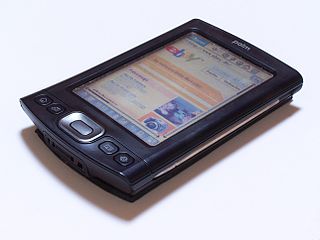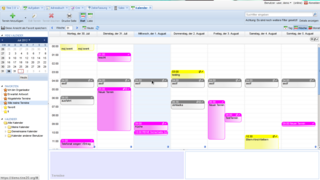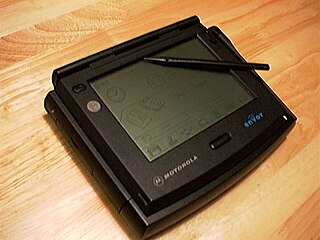
A personal digital assistant (PDA) is a multi-purpose mobile device which functions as a personal information manager. Following a boom in the 1990s and 2000s, PDA's were mostly displaced by the widespread adoption of more highly capable smartphones, in particular those based on iOS and Android in the late 2000s, and thus saw a rapid decline.

The Sony CLIÉ is a series of personal digital assistants (PDAs) running the operating system (OS) Palm OS, developed and marketed by Sony from 2000 to 2005. The devices introduced many new features to the PDA market, such as a jog dial interface, high-resolution displays, and Sony technologies like Memory Stick slots and ATRAC3 audio playback. Most models were designed and manufactured in Japan. The name was initially an attempt at a new coinage term, though it means tool in the Jèrriais language.

Palm OS is a discontinued mobile operating system initially developed by Palm, Inc., for personal digital assistants (PDAs) in 1996. Palm OS was designed for ease of use with a touchscreen-based graphical user interface. It was provided with a suite of basic applications for personal information management. Later versions of the OS were extended to support smartphones. The software appeared on the company's line of Palm devices while several other licensees have manufactured devices powered by Palm OS.

Palm is a now discontinued line of personal digital assistants (PDAs) and mobile phones developed by California-based Palm, Inc., originally called Palm Computing, Inc. Palm devices are often remembered as "the first wildly popular handheld computers," responsible for ushering in the smartphone era.

A personal organizer, also known as a datebook, date log, daybook, day planner, personal analog assistant, book planner, year planner, or agenda, is a portable book or binder designed for personal management. It typically includes sections such as a diary, calendar, address book, blank paper, checklists, and additional useful information like maps and telephone codes. It is related to the separate desktop stationery items that have one or more of the same functions, such as appointment calendars, rolodexes, notebooks, and almanacs.
Application software is any computer program that is intended for end-user use – not operating, administering or programming the computer. An application is any program that can be categorized as application software. Common types of applications include word processor, media player and accounting software.

Mobile computing is human–computer interaction in which a computer is expected to be transported during normal usage and allow for transmission of data, which can include voice and video transmissions. Mobile computing involves mobile communication, mobile hardware, and mobile software. Communication issues include ad hoc networks and infrastructure networks as well as communication properties, protocols, data formats, and concrete technologies. Hardware includes mobile devices or device components. Mobile software deals with the characteristics and requirements of mobile applications.

An electronic organizer is a small calculator-sized computer, often with an built-in diary application and other functions such as an address book and calendar, replacing paper-based personal organizers. Typically, it has a small alphanumeric keypad and an LCD screen of one, two, or three lines.
The term personal communicator has been used with several meanings. Around 1990 the next generation digital mobile phones were called digital personal communicators. Another definition, coined in 1991, is for a category of handheld devices that provide personal information manager functions and packet switched wireless data communications capabilities over wireless wide area networks such as cellular networks. These devices are now commonly referred to as smartphones.
A personal wiki is wiki software that allows individual users to organize information on their desktop or mobile computing devices in a manner similar to community wikis, but without collaborative software or multiple users.
Mobipocket SA was a French company incorporated in March 2000 that created the .mobi e-book file format and produced the Mobipocket Reader software for mobile phones, personal digital assistants (PDA) and desktop operating systems.

A digital calendar is a collaborative or personal time management software with a calendar that can be used to keep track of planned events. The calendar can also contain an appointment book, address book or contact list. Common features of digital calendars are that users can:
Mobile device management (MDM) is the administration of mobile devices, such as smartphones, tablet computers, and laptops. MDM is usually implemented with the use of a third-party product that has management features for particular vendors of mobile devices. Though closely related to Enterprise Mobility Management and Unified Endpoint Management, MDM differs slightly from both: unlike MDM, EMM includes mobile information management, BYOD, mobile application management and mobile content management, whereas UEM provides device management for endpoints like desktops, printers, IoT devices, and wearables.

The Motorola Envoy Personal Wireless Communicator was a personal digital assistant initially slated for release by Motorola in summer 1994 but delayed and then available for public sale in February 1995. It was built to run General Magic's Magic CAP operating system, and it combined wireless, telephone, and infrared modems in a single PDA package. Andy Rubin led development of the Motorola Envoy.
ThinkVantage Technologies is a set of system support utilities to reduce total cost of ownership of Lenovo brand desktop and laptop computers.

Mobile interaction is the study of interaction between mobile users and computers. Mobile interaction is an aspect of human–computer interaction that emerged when computers became small enough to enable mobile usage, around the 1990s.

Mobile device forensics is a branch of digital forensics relating to recovery of digital evidence or data from a mobile device under forensically sound conditions. The phrase mobile device usually refers to mobile phones; however, it can also relate to any digital device that has both internal memory and communication ability, including PDA devices, GPS devices and tablet computers.
The following outline is provided as an overview of and topical guide to software:

Mobile technology is the technology used for cellular communication. Mobile technology has evolved rapidly over the past few years. Since the start of this millennium, a standard mobile device has gone from being no more than a simple two-way pager to being a mobile phone, GPS navigation device, an embedded web browser and instant messaging client, and a handheld gaming console. Many experts believe that the future of computer technology rests in mobile computing with wireless networking. Mobile computing by way of tablet computers is becoming more popular. Tablets are available on the 3G and 4G networks.
The following outline is provided as an overview of and topical guide to computing:











